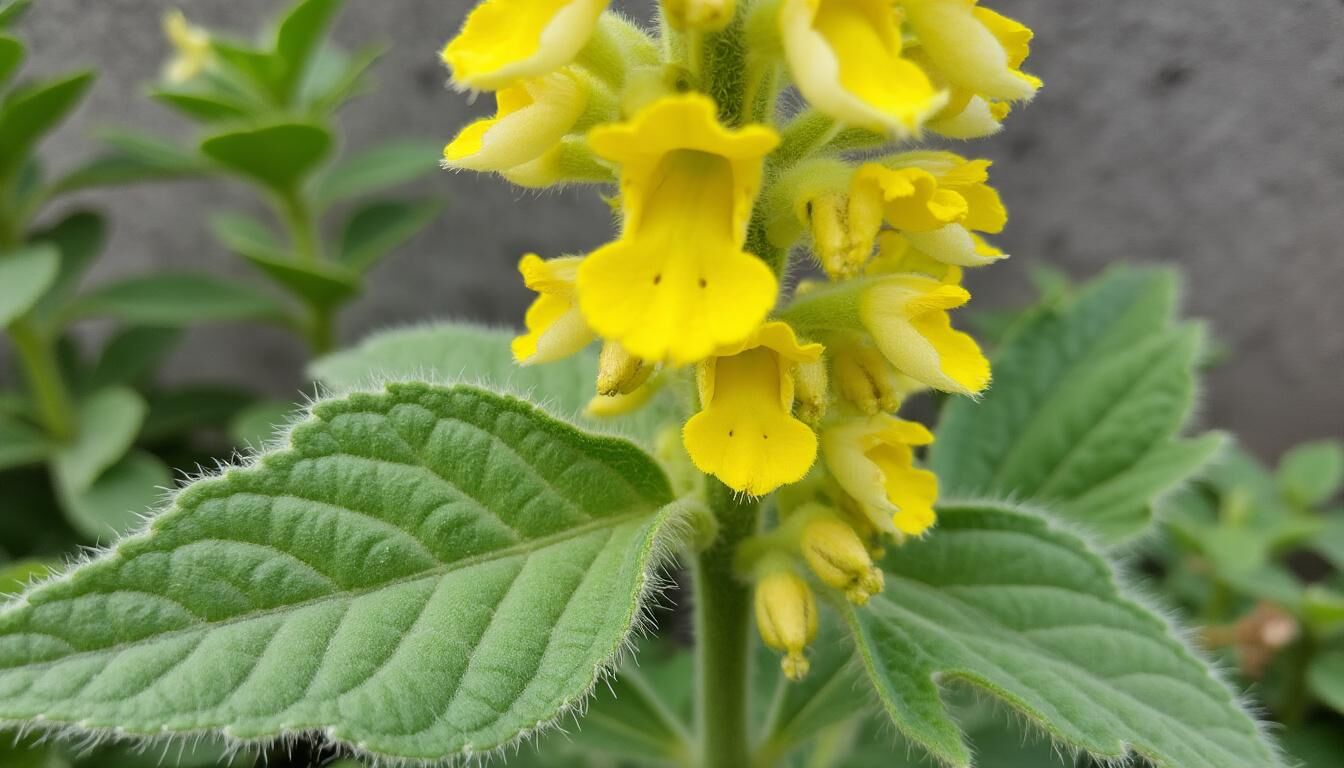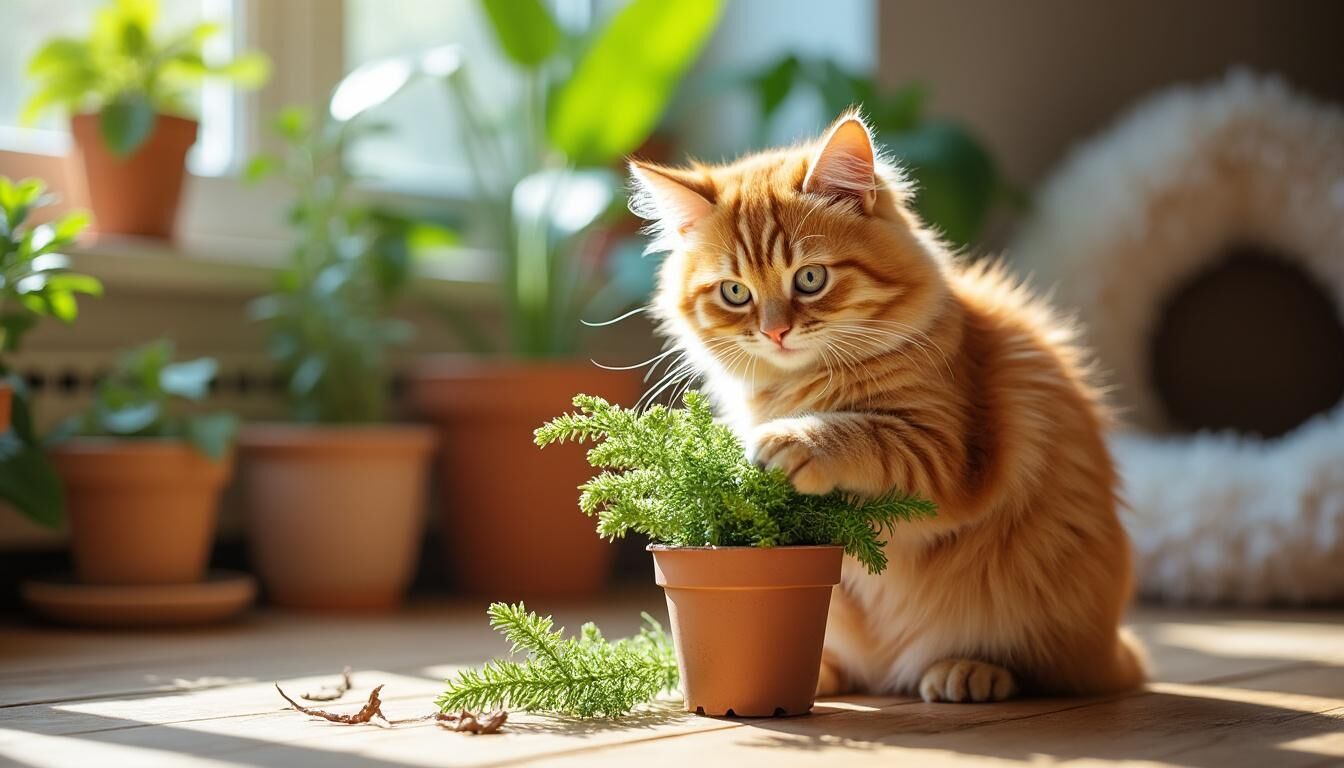The plant known as mullein (Verbascum thapsus) has been valued for centuries for its notable medicinal properties, particularly within traditional herbal medicine. In the context of cats’ healthcare, mullein offers a natural option to support various conditions, especially those related to respiratory health, inflammation, and skin comfort. Its gentle expectorant and anti-inflammatory effects make it an intriguing choice for managing feline ailments like asthma and bronchitis. However, the nuances of using this herb safely for cats must be well understood, and a veterinarian‘s guidance is essential to ensure the right balance between benefit and risk. Cats, with their sensitive systems, require careful preparation and dosing to avoid potential adverse effects that some herbal components might cause.
Mullein’s long history as a remedy spans cultures and centuries, with herbalists historically utilizing its leaves and flowers to treat human respiratory infections and inflammations. This rich heritage contributes to contemporary interest in applying its medicinal benefits to pets. Among cats, especially those prone to respiratory distress or mild inflammatory issues affecting their digestive tract or skin, mullein could serve as a complementary therapy. Nevertheless, understanding which parts of the plant are safe, how to prepare it gently, and monitoring a cat’s response over time are key factors in maximizing its efficacy without compromising safety.
What Is Mullein? 🌱 Historical Uses and Medicinal Properties for Cats
Botanical Overview: Identifying the Mullein Plant
Recognizable by its tall, flowering stalks reaching up to two meters, mullein (Verbascum thapsus) is a biennial herb featuring large, velvety leaves covered with tiny soft hairs. These hairs can cause skin irritation if directly handled without care but also contribute to the plant’s unique profile. The bright yellow flowers bloom in summer and are commonly harvested for herbal preparations, prized for their therapeutic properties.
Foliage and flower characteristics:
-
Leaves: broad, soft, woolly surface that feels like velvet
-
Flowers: five-petaled yellow clusters arranged densely along spikes
-
Stems: tall, rigid, and somewhat coarse (avoid these in treatments)
While easily sourced in temperate climates, it’s important that only the soft leaves and flowers are utilized for feline remedies, as stems and roots can carry compounds potentially toxic to cats.

Traditional Herbal Medicine: Mullein’s Place in History
Mullein has been a staple in herbal medicine dating back to antiquity, revered for its usefulness in soothing respiratory troubles and reducing inflammation. Historical texts from Europe and Asia document its application for human coughs, bronchitis, and wounds. Traditional practitioners recognized its expectorant qualities, facilitating lung clearance and easing breathing discomfort.
For cats, these longstanding uses translate into modern interest in mullein as a natural treatment for parallel problems. The herb’s roles in:
-
Helping to ease bronchial spasms in respiratory diseases like asthma
-
Promoting anti-inflammatory responses that can benefit ear infections or digestive inflammation
-
Providing antioxidant effects that potentially support immune tolerance
Through the ages, this botanical’s mild but effective profile has made it a favored candidate among herbs researched for feline health.
Medicinal Benefits of Mullein for Cats’ Health 🐾
Mullein for Feline Respiratory Support: Asthma and Bronchitis Relief
Cats suffering from respiratory ailments like asthma and bronchitis may benefit from mullein’s ability to act as a natural expectorant and antispasmodic. The herb helps loosen mucus buildup and soothes irritated bronchial tissues, facilitating easier breathing. Mullein’s calming effect can reduce the frequency and severity of respiratory spasms, a major discomfort for affected cats.
This dual action addresses two common symptoms:
-
Excessive mucus production leading to coughing and wheezing
-
Muscle spasms constricting the airways, making respiration difficult
Veterinary supervision is crucial to tailor mullein use in conjunction with any prescribed respiratory treatments. Additionally, conditions like feline asthma require comprehensive care plans including environmental controls and regular checkups.
Anti-Inflammatory and Expectant Properties: How Mullein Supports Ear and Digestive Health
The anti-inflammatory nature of mullein isn’t limited to the lungs but extends to other delicate feline systems like the ears and gastrointestinal tract. Chronic ear infections or inflammation can be soothed with extracts of mullein to reduce swelling and promote healing. Similarly, digestive discomfort related to mild inflammation benefits from mullein’s calming effects on digestive tissues.
Key benefits include:
-
Reduction of inflammation in both external and middle ear infections
-
Supporting digestive tract comfort to ease mild upset or irritation
-
Encouragement of normal mucus function, aiding digestive lining protection
For cats prone to vomiting or digestive upset, it’s vital to identify underlying causes. Persistent vomiting in cats might indicate deeper issues, a concern addressed in resources like this article, reinforcing the need for proper diagnosis alongside mullein use.
Promoting Skin Comfort and Soothing Irritations in Cats
Topical application of mullein flowers in a mild infusion can help relieve itching and inflamed skin areas in cats. While the fine hairs on raw leaves can cause irritation, processed preparations minimize this risk. The herb’s subtle antibacterial and anti-inflammatory effects aid in calming common feline skin irritations triggered by allergies or minor wounds.
When using mullein for skin care, consider:
-
Preparing a gentle tea or wash for localized application
-
Testing a small skin patch first to monitor for allergic reactions
-
Combining with other vet-approved remedies for complex skin conditions
Safe Preparation and Administration of Mullein for Felines ⚗️
Brewing Gentle Mullein Tea and Alcohol-Free Tinctures
Preparation of mullein for cats must prioritize the plant’s gentleness and absence of toxic solvents. Brewing a mild mullein tea is one preferred method, utilizing dried flowers and leaves steeped carefully in hot water and cooled for administration. Alcohol-free tinctures, commonly used in human herbal remedies, need to be specially prepared to exclude alcohol, which is harmful to cats.
-
Use only flowers and leaves, avoiding stems and roots
-
Steep herb in boiling water for 10-15 minutes to extract active compounds
-
Cool thoroughly and strain to remove fine hairs and particles
-
Administer in small doses mixed into food or water
Alcohol-free tinctures can be made using glycerin or vegetable-based solvents to safely preserve mullein’s active constituents. Commercial options labeled safe for feline use should be sourced responsibly.
Guidelines for Safe Dosage: Starting Slow and Monitoring Reaction
Administering mullein requires caution and attentiveness to dosage. Cats’ metabolisms are sensitive to changes, so it is recommended to begin treatments with minimal amounts and gradually increase only if no adverse symptoms appear. Close monitoring after each dose allows early detection of any negative responses.
-
Start with 1-2 drops of cooled mullein tea or tincture per kg of body weight
-
Observe for vomiting, diarrhea, lethargy, or changes in breathing
-
Adjust doses slowly under veterinary advice
-
Always discontinue if signs of intolerance or toxicity occur
Veterinarian Consultation: Essential Steps Before Use
Before introducing mullein as a treatment, consulting a veterinarian is non-negotiable. Professionals can evaluate a cat’s overall health status, pre-existing conditions, and potential drug interactions to ensure safety. Certain cats, including pregnant, nursing, or very young felines, require particular caution.
-
Discuss mullein’s role alongside prescribed medications
-
Request guidance on appropriate form and dosage
-
Perform bloodwork or tests if recommended for comprehensive assessment
-
Report any unusual symptoms promptly after starting herbal use
Risks, Side Effects, and Recognizing Mullein Toxicity in Cats ⚠️
Potential Side Effects: GI Upset, Allergic Reactions, and Sedation
Despite its benefits, mullein carries some risks for cats, particularly if misused. Gastrointestinal upset such as vomiting and diarrhea is a common side effect in sensitive individuals. Allergic reactions, including skin redness or itching, may occur due to the plant’s fine hairs or proteins. In rare cases, overdoses can lead to mild sedation, affecting a cat’s alertness and coordination.
Key side effects to watch for include:
-
Upset stomach and loss of appetite
-
Skin redness or rash
-
Excessive tiredness or drowsiness
Careful adherence to dosage guidelines limits these risks considerably.
Dangerous Mullein Parts: Avoid Stems and Roots
While mullein’s leaves and flowers harbor healing properties, the stems and roots contain compounds that can be toxic for cats. These parts should never be included in home preparations or commercial products intended for feline use.
-
Stems: tough, fibrous, and bitter, potentially causing GI irritation
-
Roots: concentrated alkaloids that may provoke toxicity
-
Always source mullein carefully to exclude these parts
Misidentification or careless harvesting increases the risk of poisoning, making it essential to rely on vetted sources.
Recognizing Toxicity Symptoms: When to Seek Immediate Veterinary Care
Early identification of mullein toxicity is vital to ensure prompt medical intervention. Symptoms requiring immediate veterinary attention include:
-
Persistent vomiting or diarrhea
-
Severe lethargy or unresponsiveness
-
Muscle tremors or unusual weakness
-
Difficulty breathing or rapid respiratory distress
If any of these occur after mullein administration, emergency care is necessary. Learning the signs helps cat owners act decisively to protect feline welfare.
Safe Storage: Keeping Mullein Potent and Out of Reach
Proper storage maintains mullein’s effectiveness while preventing accidental ingestion or degradation. Key points for storage:
-
Store dried mullein in airtight containers away from moisture and sunlight
-
Keep all preparations out of reach of pets, preferably in locked cabinets
-
Label clearly to avoid confusion with other herbs or medicines
Correct storage ensures consistent potency for cats’ health and reduces the risks of unintentional overdoses.
Alternatives and Ongoing Monitoring: Ensuring Your Cat’s Wellbeing 💡
Natural Alternatives to Mullein for Cat Respiratory and Inflammatory Issues
Should mullein be unsuitable or ineffective, several other herbs with supportive properties are available for feline respiratory and inflammatory concerns. These include:
-
Licorice root – anti-inflammatory and soothing
-
Marshmallow root – mucilage-rich for respiratory lining comfort
-
Chamomile – mild anti-inflammatory and calming
Before combining or switching herbs, it is vital to discuss plans with a veterinarian to prevent interactions and ensure complementary efficacy. Some plant species like Stromanthe Triostar are toxic and must be avoided strictly.
Tracking Improvements and Adverse Changes in Feline Health
Introducing any herbal supplement requires diligent observation. Cat guardians should keep detailed notes on:
-
Breathing quality and frequency of wheezing or coughing
-
Changes in appetite and digestion
-
Behavioral shifts, including restlessness or lethargy
-
Appearance of skin or ear inflammation
Regular veterinary check-ups complement at-home monitoring to ensure that treatments remain safe and effective. If negative changes arise, discontinuation and consultation are recommended without delay.
|
Aspect 🐱 |
Mullein Benefits 🌿 |
Precautions ⚠️ |
Alternatives 🌸 |
|---|---|---|---|
|
Respiratory Health |
Expectorant and antispasmodic aiding asthma and bronchitis |
Possible sedation and allergies; proper dosage essential |
Licorice root, marshmallow root |
|
Anti-Inflammatory Effects |
Calms ear and digestive tract inflammation |
Avoid stem and root parts; check for skin irritation |
Chamomile, calendula |
|
Skin Soothing |
Promotes relief of itching and minor wounds |
Fine hairs can irritate; test small skin areas first |
Aloe vera (vet-approved), calendula |
FAQ
-
Q: Can mullein be given to all cats regardless of age?
A: Very young, pregnant, or nursing cats should not receive mullein without veterinary approval due to safety concerns. -
Q: How quickly should improvements appear after starting mullein?
A: Some cats may show respiratory relief within days, but skin or digestive improvements might take longer with consistent treatment. -
Q: What should I do if my cat vomits after taking mullein?
A: Stop administration immediately and consult a veterinarian to rule out allergies or overdose. -
Q: Is it safe to combine mullein with other herbs for my cat?
A: Only under strict veterinary guidance, as combining herbs can produce unexpected effects or interactions. -
Q: Where can I find safe mullein products for cats?
A: Choose reputable veterinary herbal suppliers and check for formulations specifically intended for feline use, referencing trusted sources like this detailed guide.

